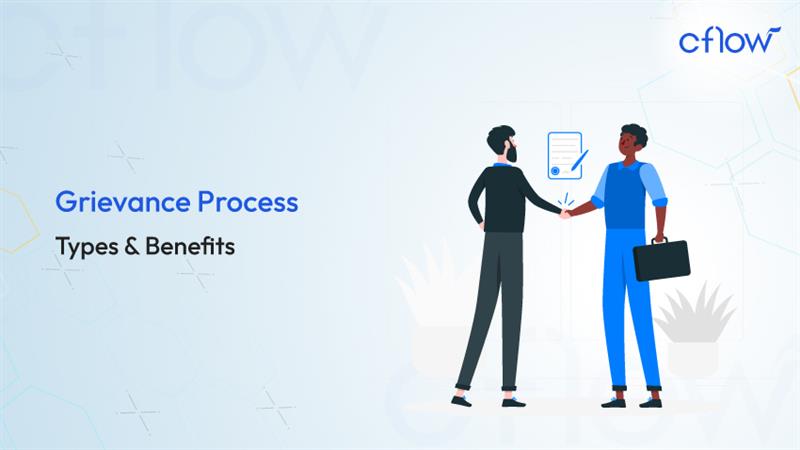Grievance Process – Types and Benefits

Key takeaways
- A grievance is an official complaint filed by one employee on a co-worker or the employer. The grievance process mitigates the issues and legitimates complaints through a standard procedure.
- The idea of the grievance process is to provide a clear track on which employers and employees can resolve issues internally. This ensures the restoration of a positive work environment.
- This process provides a space for employees to challenge the management and the decisions that they make.
- Cflow is a phenomenal automation platform that can automate the grievance process and make it efficient.
What is a Grievance?
A grievance is an official complaint or issue filed by one employee on a co-worker or the employer. The grievance process is a standard procedure that eliminates the issues and complaints. This process is implemented to ensure that the impact of issues does not brew within the team and is resolved quickly and effectively.
All issues can be resolved by following the standard procedure for addressing them without causing any further complications. The structure, format, and type of grievance process can vary depending on the organization. The idea of the grievance process is to provide a clear track on which employers and employees can resolve issues internally. This fosters the restoration of a positive work environment.
Table of Contents
Types of Employee Grievances
Individual Grievances
Individual grievances are mostly associated with employees who experience personal problems concerning their work, benefits or pay. They can be classified into two categories.
- Personal Complaints – These are grievances where an employee faces unfair treatment, discrimination, or any kind of bullying or harassment. Research shows that around 53% of organizations get employee grievances about their managers, and also issues between colleagues.
- Particular Incidents – These are issues that arise due to certain events that have impacted an individual. Some examples could be promotion denial or bias in the performance review.
Group Grievances
Group grievances happen when multiple employees face similar issues or experiences in the company. This can come out as a joint complaint. The types include –
- Common Issues – These could be problems that impact a group of employees. This could be a team or a department facing issues like a critical working environment, lack of facilities, or inadequate policies
- Collective Complaints – Collective complaints arise when multiple employees face the same work issue. These issues can include gender pay gaps, work shifts or scheduling, workload management, etc.
Union Grievances
Union grievances are generally put forward by unions of employees for issues that arise in worker rights. This usually happens when workers feel their rights are being undervalued and exploited. The types are –
- Contractual Violations – This happens when the employers do not respect the contract and violate the terms and conditions.
- Union Representations – These are issues related to the union being underrecognized and mistreated.
- Labor Disputes – These are conflicts or disputes that occur between the union and the management. These are usually based on wages, working conditions, or other term negotiations.
Organizational Grievances
These are grievances that are submitted concerning organizational functions, structure, and policies. These can be categorized as follows –
- Policy and Procedure Grievances—These are grievances concerning company policies or their implementation.
- Systemic Issues – These are issues that affect the entire organization. It can usually be a case of discrimination or management issues.
- Whistleblower Complaints – This concerns the complaints raised by employees on something unethical or illegal.
Pros and Cons of a Formal Grievance Procedure
A grievance process is an ideal and standardized way to handle issues and complaints within the organization. This process provides a space for employees to challenge the management and the decisions that they make. The workforce is also allowed to voice out their opinions and concerns without being worried about any kind of work retaliation. Moreover, these also help in fostering trust between the employees and the organization.
This helps practice effective conflict management, resolving issues promptly and fairly. However, the process can also have some disadvantages. Let us take a close look at the pros and cons of having a grievance process.
Pros of a Grievance Procedure Process –
- It ensures that there is a formal and standardized process for conflict resolution
- It facilitates proper documentation, including the proof of grievances raised as well as the conclusion that is agreed upon
- It improves the transparency in how issues, concerns, and conflicts are handled and resolved
- It helps manage the small issues to not grow into a larger conflict
- It nurtures trust and openness among the workforce and builds a healthy work environment
- It ensures that the employees feel validated with their concerns
- It ensures that the company has strong, ethical, and employee-friendly policies
- In the case of union situations, an official representative or attorney will represent the issue raised
- It strictly prevents cases of employee bias, discrimination, and harassment
- It helps avoid litigation
Cons of a Grievance Procedure Process –
- A formal procedure makes it discouraging for the employees to complain about minor issues which can induce a stressful environment
- Cases where managers or upper management do not take the grievance seriously when it is a minor issue
- Bigger issues involving multiple employees can drag the process and take a long time to get resolved, affecting the work dynamic
- Some employee unions can use this process to bring the company down in case something does not go their way
- The process is an additional paperwork process for the human resources management department
- Employees raising false grievance requests.
- Cases of employees quitting when grievances are not handled properly
5 Broad Grievance Procedure Steps
1. Informal Meet with a Supervisor
In a general grievance process, the stage is where the employee meets with their immediate supervisor and discusses the issues and their effects. This meeting aims at resolving the issue here in the informal stage itself. The supervisor tries to resolve it by speaking with the involved parties. If the complainer is not satisfied, the process takes the formal route of grievance resolution.
2. File a Grievance in Writing
The first step of registering a grievance officially is to fill out the grievance form that is accessible to the workforce and management. As an additional step, a formal outline of the grievance can be mailed as well. To make the process easier and fair, it is ideal to give details like names, dates, proofs, etc.
3. Review the Grievance
The next stage is where the grievance submitted is reviewed. Here the human resources department is involved in reviewing the grievance form submitted. Along with the HRM department, if the company has an employee union, the review can include the union representative, to ensure that every step is done fairly and unbiased.
4. Conduct a Formal Investigation
Once everything has been reviewed and validated, a formal investigation must be initiated that will include the interview with all the employees involved in the conflict. The investigation will include the gathering of all evidence and proof that contribute to offering a clear picture of the incident. These will help the process to be impartial.
5. Resolve the Grievance
The final stage is where the conflict is resolved. With effective communication with the employees involved, a conclusion is written and documented. The complainer is given the final response and the steps the company is planning to take. If the employee is not satisfied with the outcome, a mediator can be appointed to make everything appealing to all parties.
End-to-end workflow automation
Build fully-customizable, no code process workflows in a jiffy.
Handling the Grievance Process Through Automation
The grievance process can often bring down the efficiency of the performance and create downtime in the working environment. Automation is an outstanding solution to be leveraged that will ensure that the process can be effectively carried out in organizations, without any delays affecting the working system.
Automation lets you streamline the complete process, bringing together the employees and management members involved. Grievance forms can be digitized making the submission process easy. The form will be automatically routed to the reviewer for further processing. The grievance process will no longer be cumbersome or delayed, allowing a faster resolution and a healthy working environment for the workforce.
Why Choose Cflow to Automate the Grievance Process?
Cflow is a phenomenal automation platform that can automate the grievance process and make it efficient. It offers AI-powered transformation solutions, workflow automation, API integration, intelligent document management, and task management. As a tool that is best suitable for SMBs and enterprise businesses, of any industry, catering to multiple processes and administrative works, saving time, maintaining accuracy, and ensuring process compliance. The grievance process will no longer be a hassle, will facilitate a healthy working environment, and empower them to perform better.
With Cflow organizations can get –
- Workflow templates
- Security and backup
- Flexible approval process
- No-code orientation
- Top-class features
- Budget-friendly plans
On a Final Note
Conflict is an inevitable part of any organization and can arise due to multiple reasons. Trying to completely erase them is not a viable option, however, handling them effectively is one. This is why organizations must have a solid and automated grievance process to resolve conflicts instantly. Cflow is a promising tool that can do this efficiently. Automating the process using Cflow’s automation solution can seamlessly avoid any escalation of conflicts or legal issues. Sign up on Cflow to know more!
What should you do next?
Thanks for reading till the end. Here are 3 ways we can help you automate your business:

Do better workflow automation with Cflow
Create workflows with multiple steps, parallel reviewals. auto approvals, public forms, etc. to save time and cost.

Talk to a workflow expert
Get a 30-min. free consultation with our Workflow expert to optimize your daily tasks.

Get smarter with our workflow resources
Explore our workflow automation blogs, ebooks, and other resources to master workflow automation.

